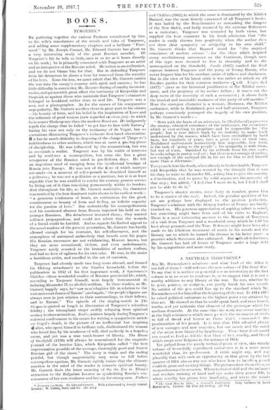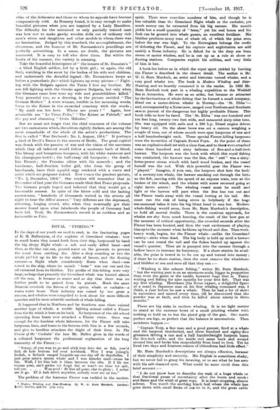A NEUTRAL'S INDICFMENT.•
Ara Mr. Raennekers's admirers—and what lend of the Allies is not full of them r—n•ill welems, the new volume of 7'he Gras! lint To say that it is neither so powerful tine so interesting as the firm volume is in no Sense to 00114"11), it, or to suggest that it is not worthy addition to any library of the war. No one, whether he be poet, painter, or sculpter, can yearly break his own recant. No satirist of the pen could live up to the standard which 51r, Raemaekers net for himself at the beginning of the war. In 914-1915 he raised political caricature to the highest point ever Misdeed by that art. He showed us that he could speak hard, and even brute), truths, and yet maintain that clement of the grotesque which his medium demands. At the same tire, his work was stover wantin s in the high seriousness which meet sp with the treatment, of dents no full of dread and horror as those which cemmunled taro proclamation of his pencil. It is true that 1910 afforded plenty of nose outrages and new tragedies, but our inhale and the mind of the artist were blunted by familiarity. Theso later IL ;este could net sound ea laud res did the first blast of tun, cruelty, and broad whirls swept over Belgium in the autumn of 1914.
Yet judged from the purely technical point of view, this stately volume of beautifully reproduced caricatures is in a sense nsoro wonderful than its predecessor. A critic might arty, and sty plausibly that with such an opportunity as that given by the last quarter of 1914 almost any one who knew how to handle q pencil could do great and moving things. The pictures drew tin in selves, so tremendous was the occasion. Where technical skill and the int inlet" and resolute training of hand and eye make their power felt, is where novelty has growls into familiarity, and where the minds
• She Great War to 1016: a siderite. IseGentint. Silty ttilL0010 by 1.01117
Paennekers, London: The line art soeiety. 05.1
Alike of the delineator and those to whom he appeals have become comparatively cold. As Romney found, it is easy enough to make beautiful pictures when you are inspired by a Lady Hamilton. The difficulty for the untrained or only partially trained man was how not to make gawky wooden dolls out of ordinary rich men's wives and daughters and other models in whom there was no fascination. Judged by this standard, the accomplishment, the cleverness, and the humour of Mr. Raemaekers's pencillings are perfectly astonishing. In a sense; no doubt, the pictures. are mannered. It is easy to toll who drew them. But within the limits of his manner, the variety is amazing.
Take the beautiful frontispiece of " the inmate of St. Dunatan's " --a blind English soldier, led by a little girl ; or again, the old Serb, watching in the snow by the bodies of his wife and children, and underneath the dreadful legend—AD. Raernaekers keeps as before a journalistic flair which lightens up every picture—" Fight- ing wills the Bulgara against the Turks I lost my brother. My son fell fighting with the Greeks against Bulgaria, but only when the Germans came here were my wife and grandchildren killed." Very powerful too, as a drawing, is the picture entitled " The- Germ. Mother." A worn woman, terrible in her mourning WaXIII, turas to the Kaiser in the enowelad cemetery with the words ; " My sixth son lies hers. Whore are yours 1 " Again, how admirable are " Le Vieux Poilu," " The Kaiser as Falstaff," and the gay and charming Croix Militaire."
But we must not forget that the chief treasures of the volume arc two caricatures which, theeditors rightly declare, are among the most remarkable of the whole of the artist's productions. The first is called " War Declared No. 1, August, 1914." It portrays g kind of Devil's Dance in the streets of Berlin. The great capital was drunk with the passion of war and the vision of the successes which they all believed would follow a moderate bath of blood. The blousy and bumptious bourgeois, with his white waistcoat and his champagne-bottle ; the half-crazy old bourgeoise ; the death- like Pierrot ; the Prussian officer with his monocle ; and the handsome, half-drunken ballet girl, who form the group of beerhanals, have their squalid orgy rendered with a verve and spirit which are poignant indeed. Now comes the pendent picture, "No. 2, December, 1910." Our readers will remember that in December of last year the Germans made their first Peace proposals. The German people hoped and believed that they would get a favourable answer. In spite of the bitter cold and the lashing snowstorms, "hundreds of thousands waited in the streets all night to hear the Allies' answer." Very different are the depressed, shivering, longing crowd, who when they eventually got their answer found upon what falsehoods the people of Germany had been fed. Truly Mr. Raernaekers's record is as ruthless and as inexorable as Fate.



































 Previous page
Previous page